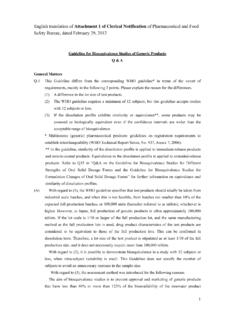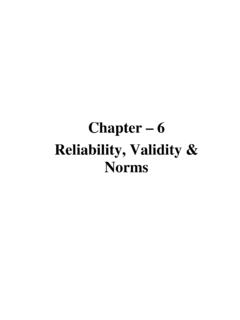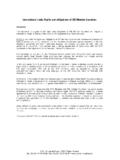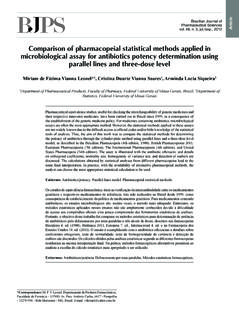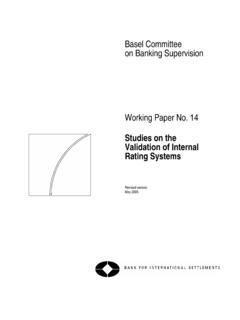Transcription of Techniques and Method's of Translation - IOSR …
1 IOSR Journal Of Humanities And Social Science (IOSR-JHSS) e-ISSN: 2279-0837, p-ISSN: 2279-0845. PP 40-42 40 | Page Techniques and Method's of Translation Umamaheshwari .J Asst Professor of English, Bharathiyar University Arts & Science College, Sivagiri, Erode Abstract: Translation studies is an academic interdiscipline dealing with the systematic study of the theory, description and application of Translation , interpreting, and localization. As an interdiscipline, Translation Studies borrows much from the various fields of study that support Translation .
2 These include comparative literature, computer science, history, linguistics, philology, philosophy, semiotics, and terminology. The term Translation studies was coined by the Amsterdam-based American scholar James S. Holmes in his paper "The name and nature of Translation studies",[1] which is considered a foundational statement for the discipline.[2] In English, writers occasionally use the term "translatology" (and less commonly "traductology") to refer to Translation studies, and the corresponding French term for the discipline is usually traductologie (as in the Soci t Fran aise de Traductologie).
3 In the United States there is a preference for the term Translation and Interpreting Studies (as in the American Translation and Interpreting Studies Association), although European tradition includes interpreting within Translation studies (as in the European Society for Translation Studies). I. Introduction Way back in the 1950s, two French scholars named Jean-Paul Vinay and Jean Darbelnet explored the linguistic aspects of Translation . The field of Translation Studies didn't really exist at the time, so most of what Vinay and Darbelnet did was considered comparative literature.
4 When looking at the work of Vinay and Darbelnet, the term contrastive linguistics seems much more appropriate, as what they did was look at the differences between two languages in order to inform their understanding of both of them. While other scholars sought to merely compare two languages in order to inform the relationship between them, Vinay and Darbelnet looked at the process of Translation . Their efforts culminated in what is considered their seminal work in the linguistic turn of Translation studies, Stylistique compar e du fran ais et de l'anglais : m thode de traduction, which around four decades later was translated into an English version, Comparative stylistics of French and English : a methodology for Translation .
5 The fact that it was still worth translating into English nearly half a century later shows you just how important it was. In the book, Vinay and Darbelnet posited that there were seven main processes, or procedures, at work during any given Translation . Here's the seven they came up with: II. Borrowing Borrowing is the taking of words directly from one language into another without Translation . Many English words are "borrowed" into other languages; for example software in the field of technology and funk in culture. English also borrows numerous words from other languages; abbatoire, caf , pass and r sum from French; hamburger and kindergarten from German; bandana, musk and sugar from Sanskrit.
6 Borrowed words are often printed in italics when they are considered to be "foreign". Unless you are one of these people that confuses borrowing and lending, then this should cause you little trouble. Borrowing is the idea of taking the word from the source language (SL) and maintaining it in the target language (TL). It is considered the simplest of the procedures and tends to be employed in two situations: either when discussing a new technical process for which no term exists within the TL, or when maintaining a word from the SL for stylistic effect, in which the translator uses the foreign term to add flavour to the target text (TT).
7 III. Calque A calque or loan Translation (itself a calque of German Lehn bersetzung) is a phrase borrowed from another language and translated literally word-for-word. You often see them in specialized or internationalized fields such as quality assurance (aseguramiento de calidad, assurance qualit taken from English). Examples that have been absorbed into English include standpoint and beer garden from German Standpunkt and Biergarten; breakfast from French d jeuner (which now means lunch in Europe, but maintains the same meaning of breakfast in Qu bec).
8 Some calques can become widely accepted in the target language (such as standpoint, beer garden and breakfast and Spanish peso mosca and Casa Blanca from English flyweight and White House). The meaning other calques can be rather obscure for most people, especially when they relate to specific vocations Techniques And Method's Of Translation 41 | Page or subjects such as science and law. Soluci n de compromiso is a Spanish legal term taken from the English compromise solution and although Spanish attorneys understand it, the meaning is not readily understood by the layman.
9 An unsuccessful calque can be extremely unnatural, and can cause unwanted humor, often interpreted as indicating the lack of expertise of the translator in the target language. A calque is when an expression from the source text (ST) is transferred literally into the TT. Calques either follow the syntax of the TL while translating each word literally or ignore the syntax of the TL and maintain the syntax of the SL, rendering the calque in an awkward syntactical structure in the TT. IV. Literal Translation A word-for-word Translation can be used in some languages and not others dependent on the sentence structure: El equipo est trabajando para terminar el informe would translate into English as The team is working to finish the report.
10 Sometimes it works and sometimes it does not. For example, the Spanish sentence above could not be translated into French or German using this technique because the French and German sentence structures are different. And because one sentence can be translated literally across languages does not mean that all sentences can be translated literally. El equipo experimentado est trabajando para terminar el informe translates into English as The experienced team is working to finish the report ("experienced" and "team" are reversed). The third Translation method is only to be used under certain circumstances according to Vinay and Darbelnet.










